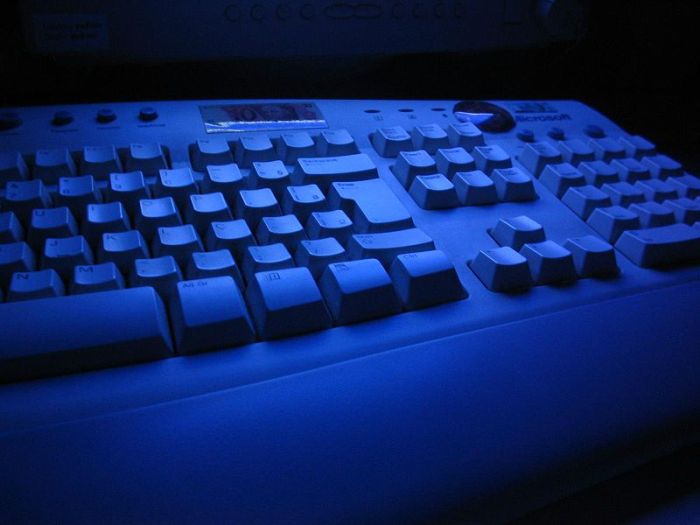The Keyboard of the Future May Reveal Your Emotions as You Type
![By Tom Stefanac (Own work) [GFDL (http://www.gnu.org/copyleft/fdl.html) or CC-BY-SA-3.0-2.5-2.0-1.0 (http://creativecommons.org/licenses/by-sa/3.0)], via Wikimedia Commons](https://techtheday.com/wp-content/uploads/2014/09/smart-keyboard.jpg)
By Tom Stefanac (Own work) [GFDL (http://www.gnu.org/copyleft/fdl.html) or CC-BY-SA-3.0-2.5-2.0-1.0 (http://creativecommons.org/licenses/by-sa/3.0)], via Wikimedia Commons
In the future, keyboards may start detecting your emotions or state of mind not just through the texts you key in but also through the way you type. As keyboards become smarter, you may start seeing warnings on your screen advising you that postpone the sending of reply email because you are angry or telling you to get some rest because the typos and other mistakes you are committing are uncharacteristic of your normal work with the keyboard. The keyboard of the future may know how you feel and may provide some feedback you can use.
Relationship Between Keyboard Use Behavior and Emotions
Researchers from the Islamic University of Technology in Bangladesh studied the subject of “emotionally aware” machines that don’t just serve as tools for humans. Nazmul Haque Nahin, Hasan Mahmud, Jawad Mohammad Alam, and Kamrul Hasan. To establish standards on how to measure the emotions of those who use keyboards, the researchers used a software to determine the emotional states of those who use keyboards. This software displayed a pop-up window that asks users to choose (by clicking on tick boxes) how they feel based on the standard ISEAR (International Survey on Emotion Antecedents and Reactions). The nine emotions are anger, fear, joy/happiness, disgust, shame, sadness, guilt, tired, and neutral.
The software matched certain behaviors with the keyword to certain emotions. These behaviors include the speed of typing, dwell time or the amount of time it takes to press and release one key before pressing another, and key down-to-down time. The participants in the test were asked to type one standard text and another they came up on their own. Aside from analyzing the behavior in using the keyboard, the content of the texts written by the participants on their own were also analyzed using VSM or Vector Space Model analysis.
For the final analysis, the researchers only considered the instances wherein both the keyboard habit and text content analysis appeared to be similar or congruent. This means that if the keyboard stroke patterns appeared angry or agitated while the content of the text written had an opposite perceived emotion, such instance was excluded from the final analysis.
The researchers found that determining emotions through keyboard analysis can be improved by adding text analysis. The researchers then developed a program that made use of keyboard analysis and text content factors to test computer user emotions. When the program was tested, it was able to successfully detect joy 87% of the time and anger with 81% accuracy.
Emotionally Aware Machines
The research paves the way for machines that react to human emotions. It can be applied to the keyboards of laptop or desktop computers in conjunction with an instant messaging app that has the ability to reflect human emotions, replacing the overused emoticons that are often arbitrary and superfluous. On the other hand, it can also be used to provide reminders to computer users on their emotional state while working on something. A prompt or reminder may be flashed on screen advising a computer user to cool down before composing an email. Gaming can also benefit from the development of emotion-reading keyboards.
The ability to determine emotions through keyboard use can also help enhance the human-computer interface. Through “smart keyboards,” users may start caring about how they are handling their machines. They may try to be more careful in pressing keys or buttons while developing the ability to more precisely type in words, to avoid overusing the Delete or Backspace keys.
Limitations
It has to be emphasized, however, that the research is not really that conclusive. While the potential for emotion detection through keyboard use analysis is there, the methodology of the research mentioned here is not that solid. For instance, the researchers have disregarded results when the expected emotions associated with keyboard use and text content were not similar. Moreover, the keyboard monitoring can also be construed as a form of privacy invasion. Not many may like being tracked, even just for their keyboard usage, while using their computers.
![By Jonymamilou (Je l'ai prise) [GFDL (http://www.gnu.org/copyleft/fdl.html), CC-BY-SA-3.0 (http://creativecommons.org/licenses/by-sa/3.0/) or CC-BY-2.5 (http://creativecommons.org/licenses/by/2.5)], via Wikimedia Commons](https://techtheday.com/wp-content/uploads/2014/09/advanced-keyboard.jpg)
By Jonymamilou (Je l’ai prise) [GFDL (http://www.gnu.org/copyleft/fdl.html), CC-BY-SA-3.0 (http://creativecommons.org/licenses/by-sa/3.0/) or CC-BY-2.5 (http://creativecommons.org/licenses/by/2.5)], via Wikimedia Commons
There have been a number of other attempts to determine computer user emotions before. Some of which involved the use of cameras, thermal imaging, and skin sensors. However, exploring the potentials of keyboard use analysis is being pursued since it is cheaper and more practical as it does not require additional hardware. In one research at the University of Saskatchewan entitled “Identifying Emotional States Using Keystroke Dynamics,” it was noted that keyboard analysis offers the advantages of being less expensive and less invasive.
For now, there have been no actual implementations of a real emotion detecting machine based on the research mentioned above. It may still take time before keyboard manufacturers or computer hardware makers integrate the necessary technology in both the software and hardware aspects.
